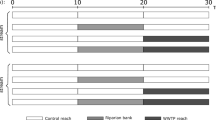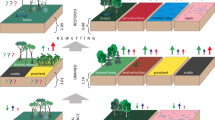Abstract
Drainage of peatlands for forestry starts a succession of ground vegetation in which mire species are gradually replaced by forest species. Some mire plant communities vanish quickly following the water-level drawdown; some may prevail longer in the moister patches of peatland. Drainage ditches, as a new kind of surface, introduce another component of spatial variation in drained peatlands. These variations were hypothesized to affect methane (CH4) fluxes from drained peatlands. Methane fluxes from different plant communities and unvegetated surfaces, including ditches, were measured at the drained part of Lakkasuo mire, Central Finland. The fluxes were found to be related to peatland site type, plant community, water-table position and soil temperature. At nutrient-rich fen sites fluxes between plant communities differed only a little: almost all plots acted as CH4 sinks (−0.9 to −0.4 mg CH4 m−2 d−1), with the exception of Eriophorum angustifolium Honck. communities, which emitted 0.9 g CH4 m−2 d−1. At nutrient-poor bog site the differences between plant communities were clearer. The highest emissions were measured from Eriophorum vaginatum L. communities (29.7 mg CH4 m−2 d−1), with a decreasing trend to Sphagna (10.0 mg CH4 m−2 d−1) and forest moss communities (2.6 mg CH4 m−2 d−1). CH4 emissions from different kinds of ditches were highly variable, and extremely high emissions (summertime averages 182–600 mg CH4 m−2 d−1) were measured from continuously water-covered ditches at the drained fen. Variability in the emissions was caused by differences in the origin and movement of water in the ditches, as well as differences in vegetation communities in the ditches. While drainage on average greatly decreases CH4 emissions from peatlands, a great spatial variability in fluxes is emerged. Emissions from ditches constantly covered with water, may in some cases have a great impact on the overall CH4 emissions from drained peatlands.
Similar content being viewed by others
References
Borgå P, Nilsson M, Tunlid A (1994) Bacterial communities in peat in relation to botanical composition as revealed by phospholipid fatty acid analysis. Soil Biol Biochem 26:841–848
Fisk MC, Ruether KF, Yavitt JB (2003) Microbial activity and functional composition among northern peatland ecosystems. Soil Biol Biochem 35:591–602
Bubier JL, Moore TR (1994) An Ecological Perspective on Methane Emissions from Northern Wetlands. Trends Ecol Evol 9:460–464
Crill PM, Martikainen PJ, Nykänen H, Silvola J (1994) Temperature and N-fertilization effects on methane oxidation in a drained peatland soil. Soil Biol Biochem 26:1331–1339
Daulat WE, Clymo RS (1998) Effects of temperature and water table on the efflux of methane from peatland surface cores. Atmos Environ 32: 3207–3218
Frenzel P, Rudolph J (1998) Methane emission from a wetland plant: the role of CH4 oxidation in Eriophorum. Plant Soil 202:27–32
Galand PE, Juottonen H, Fritze H, Yrjälä K (2005) Methanogen communities in a drained bog: effect of ash fertilization. Microb Ecol 49:209–217
Glenn S, Heyes A, Moore T (1993) Carbon-dioxide and methane fluxes from drained peat soils, southern Quebec. Glob Biogeochem Cycle 7:247–257
Huttunen JT, Nykänen H, Martikainen PJ, Nieminen M (2003) Fluxes of nitrous oxide and methane from drained peatlands following forest clear-felling in southern Finland. Plant Soil 255:457–462
Jaatinen K, Tuittila E-S, Laine J, Yrjälä K, Fritze H (2005) Methane-oxidizing bacteria (MOB) in a Finnish raised mire complex: effects of site fertility and drainage. Microb Ecol 50:429–439, (DOI: 10.1007/s00248-005-0219-7)
Joabsson A, Christensen TR, Wallén B (1999) Vascular plant controls on methane emissions from northern peatforming wetlands. Trends Ecol Evol 14:385–388
Kankaala P, Huotari J, Peltomaa E, Saloranta T, Ojala A (2006) Methanotrophic activity in relation to methane efflux and total heterotrophic bacterial production in a stratified, humic, boreal lake. Limnol Oceanogr 51:1195–1204
Keltikangas M, Laine J, Puttonen P, Seppälä K (1986) Vuosina 1930–1978 metsäojitetut suot: ojitusalueiden inventoinnin tuloksia. (Summary: Peatlands drained for forestry during 1930–1978: results from field surveys of drained areas). Acta For Fenn 193:1–94
Kettunen A (2003) Connecting methane fluxes to vegetation cover and water table fluctuations at microsite level: a modeling study. Glob Biogeochem Cycle 17(2), DOI: 10.1029/2002GB001958
Kettunen A, Kaitala V, Lehtinen A, Lohila A, Alm J, Silvola J, Martikainen PJ (1999) Methane production and oxidation potentials in relation to water table fluctuations in two boreal mires. Soil Biol Biochem 31:1741–1749
Kling GW, Kipphut GW, Miller MC (1992) The flux of CO2 and CH4 from lakes and rivers in arctic Alaska. Hydrobiologia 240:23–36
Laiho R, Vasander H, Penttilä T, Laine J (2003) Dynamics of plant-mediated organic matter and nutrient cycling following water-level drawdown in boreal peatlands. Glob Biogeochem Cycle 17(2), DOI: 10.1029/2002GB002015
Laine J (1989) Metsäojitettujen soiden luokittelu. (Summary: Classification of peatlands drained for forestry). Suo 40:37–51
Laine J, Vanha-Majamaa I (1992) Vegetation ecology along a trophic gradient on drained pine mires in southern Finland. Ann Bot Fenn 29:213–233
Laine J, Vasander H, Laiho R (1995) Long-term effects of water level drawdown on the vegetation of drained pine mires in southern Finland. J Appl Ecol 32:785–802
Laine J, Komulainen VM, Laiho R, Minkkinen K, Rasinmäki A, Sallantaus T, Sarkkola S, Silvan N, Tolonen K, Tuittila ES, Vasander H, Päivänen J (2004) Lakkasuo – a guide to mire ecosystem. Publications from the Department of Forest Ecology, University of Helsinki 31:1–123
Martikainen PJ, Nykänen H, Alm J, Silvola J (1995) Change in fluxes of carbon dioxide, methane and nitrous oxide due to forest drainage of mire sites of different trophy. Plant Soil 168–169:571–577
Minkkinen K, Laine J, Nykänen H, Martikainen PJ (1997) Importance of drainage ditches in emissions of methane from mires drained for forestry. Can J For Res Rev Can Rech For 27:949–952
Minkkinen K, Vasander H, Jauhiainen S, Karsisto M, Laine J (1999) Post-drainage changes in vegetation composition and carbon balance in Lakkasuo mire, Central Finland. Plant Soil 207:107–120
Minkkinen K, Korhonen R, Savolainen I, Laine J (2002) Carbon balance and radiative forcing of Finnish peatlands 1900–2100 – the impact of forestry drainage. Glob Change Biol 8:785–799
Nykänen H, Silvola J, Alm J, Martikainen PJ (1996) Fluxes of greenhouse gases CH4, CO2 and N2O on some peat mining areas in Finland. In: Laiho R (ed) Northern peatlands in global climatic change. Proceedings of the International Workshop held in Hyytiälä, Finland, 8–12 October 1995. Publications of the Academy of Finland 1/96, Edita, Helsinki, pp 141–147
Nykänen H, Alm J, Silvola J, Tolonen K, Martikainen PJ (1998) Methane fluxes on boreal peatlands of different fertility and the effect of long-term experimental lowering of the water table on flux rates. Glob Biogeochem Cycle 12:53–69
Paavilainen E, Päivänen J (1995) Peatland forestry – ecology and principles. Springer, Berlin, Heidelberg, New York, 248 pp
Raghoebarsing AA, Smolders AJP, Schmid MC, Rijpstra WIC, Wolters-Arts M, Derksen J, Jetten MSM, Schouten S, Damste JSS, Lamers LPM, Roelofs JGM, den Camp HJMO, Strous M (2005) Methanotrophic symbionts provide carbon for photosynthesis in peat bogs. Nature 436:1153–1156
Roulet NT, Moore TR (1995) The effect of forestry drainage practices on the emission of methane from northern peatlands. Can J For Res Rev Can Rech For 25:491–499
Schiller CL, Hastie DR (1996) Nitrous oxide and methane fluxes from perturbed and unperturbed boreal forest sites in northern Ontario. J Geophys Res Atmospheres 101:22767–22774
Schimel JP (1995) Plant transport and methane production as controls on methane flux from arctic wet meadow tundra. Biogeochemistry 28:183–200
Ström L, Ekberg A, Mastepanov M, Christensen TR (2003) The effect of vascular plants on carbon turnover and methane emissions from a tundra wetland. Glob Change Biol 9:1185–1192
Ström L, Mastepanov M, Christensen TR (2005) Species-specific effects of vascular plants on carbon turnover and methane emissions from wetlands. Biogeochemistry 75:65–82
Sundh I, Nilsson M, Mikkelä C, Granberg G, Svensson BH (2000) Fluxes of methane and carbon dioxide on peat-mining areas in Sweden. Ambio 29:499–503
Waddington JM, Roulet NT, Swanson RV (1996) Water table control of CH4 emission enhancement by vascular plants in boreal peatlands. J Geophys Res Atmospheres 101:22775–22785
Whiting GJ, Chanton JP (1993) Primary production control of methane emission from wetlands. Nature 364:794–795
Author information
Authors and Affiliations
Corresponding author
Rights and permissions
About this article
Cite this article
Minkkinen, K., Laine, J. Vegetation heterogeneity and ditches create spatial variability in methane fluxes from peatlands drained for forestry. Plant Soil 285, 289–304 (2006). https://doi.org/10.1007/s11104-006-9016-4
Received:
Accepted:
Published:
Issue Date:
DOI: https://doi.org/10.1007/s11104-006-9016-4




